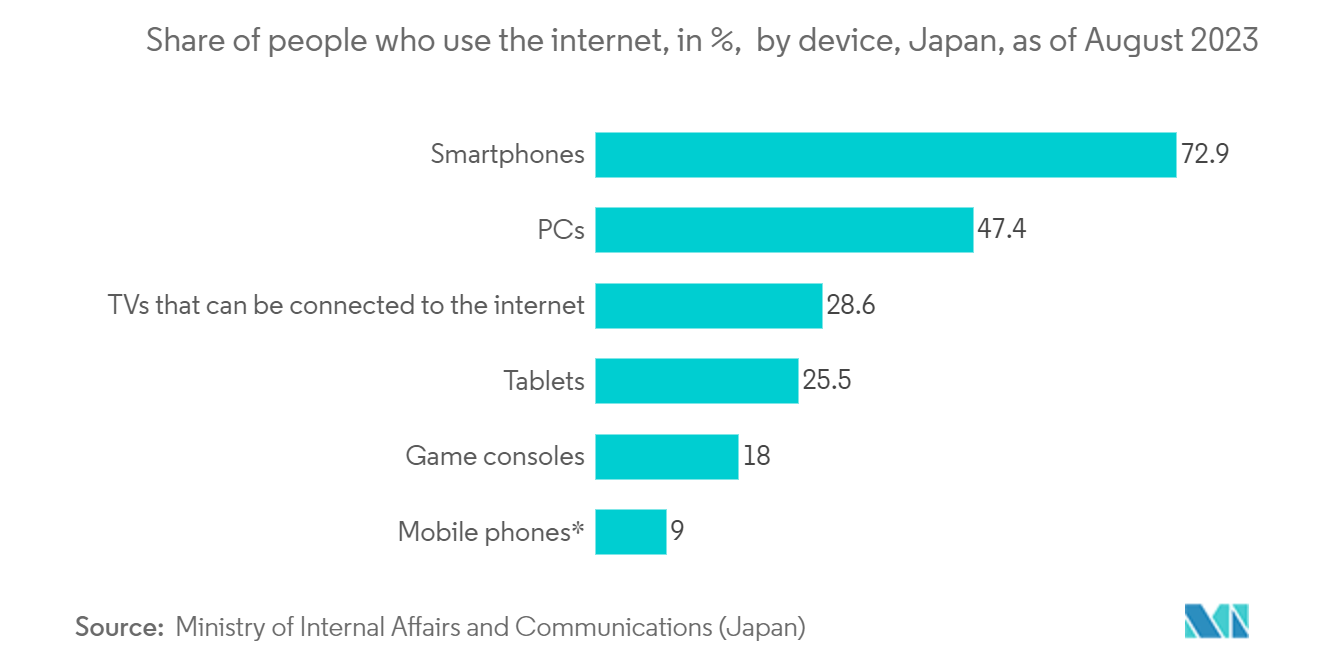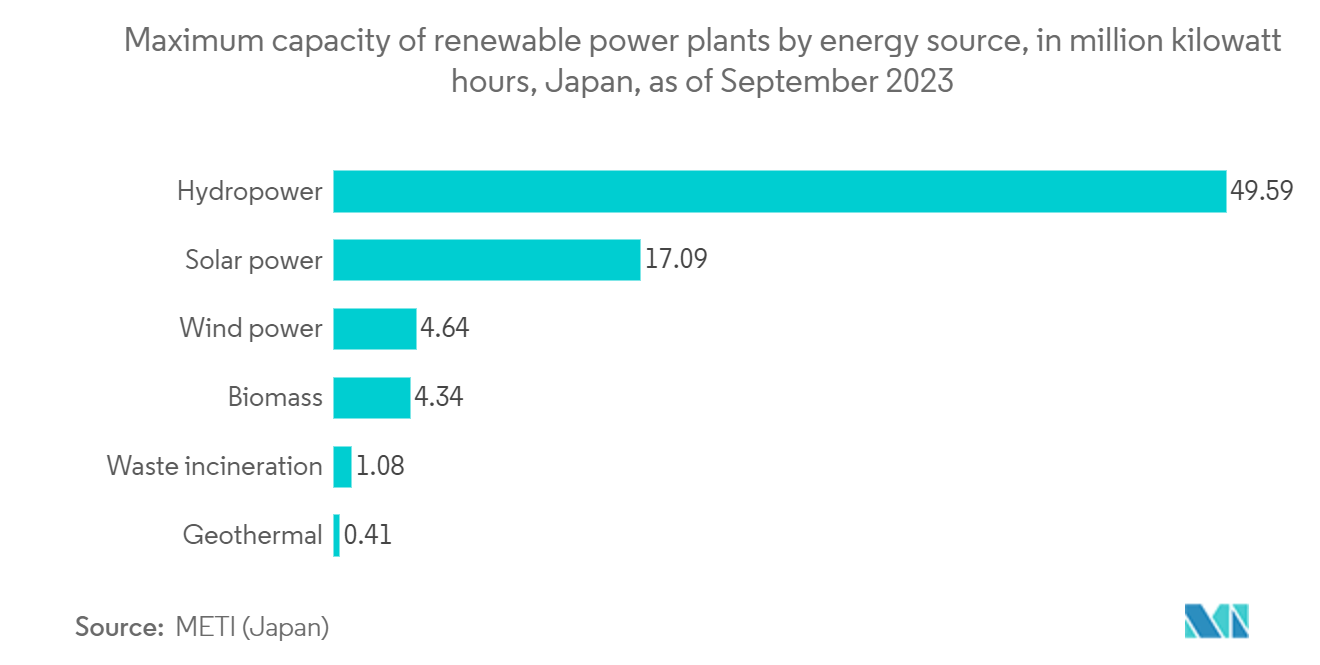Market Trends of Japan Telecom Towers Industry
5G is Expected to be a Catalyst for the Market's Growth
- The Japanese government expects 5G coverage to reach 99% of the population by the end of FY 2030. Smartphones and PCs are major contributors to the internet among populations and are expected to increase their penetration in the 5G era.
- Japanese Prime Minister Kishida presented his Vision for a Digital Garden City Nation, which seeks to achieve rural-urban digital integration and transformation to maintain future prosperity in the outlying regions of Japan and encourage many people around the world to gain a deeper understanding of and connection with the country's rural areas. One of the goals of the vision is to provide 5G service to 90% of the Japanese population by the end of FY2023 (March 31, 2024). It is expected that this will drive the country's Telecom Tower Market.
- By accelerating the rollout of 5G throughout the nation, Japanese telecom operator SoftBank hoped to raise JPY 35 billion (about USD 0.25 billion) to address social challenges in its home market. The money, known as a "Social Loan," will only be used to build 5G base stations. Although the project aims to address social issues in Japan, such advancements are expected to stimulate the country's telecom tower market, as the 5G developments require towers for antennas and stations.
- The government has been a pioneer in ICT initiatives. Strategies like e-Japan Phase I & II and the i-Japan Strategy 2015 focused on developing high-speed internet access, telecom towers, e-government, etc. These initiatives aimed to link the digital divide and adopt a digital society.
- With the primary goal of delivering local 5G networks in Japan, Cisco and partners JTower, Mitsui Knowledge Company (MKI), and Airspan Networks have developed a local 5G Open RAN (O-RAN) environment for in-building infrastructure sharing. Airspan's 5G vRAN, JTower's Local 5G in-building infrastructure sharing system, Cisco Private 5G, and MKI are used in the deployment, while MKI is in charge of building and testing the end-to-end 5G wireless environments. In the period under study, such innovations are anticipated to propel the Japanese telecom tower industry.
- In September 2023, NTT Docomo announced that a new master transaction contract had been concluded with Japan’s JTower. The agreement ensures a further 1,552 DOCOMO towers will be transferred to the Japanese towers and in-building solution provider following an early deal made in March 2022. The agreement is expected to be worth USD 114 million, and NTT stated it is actively working to build a viable 5G network by promoting infrastructure sharing. This transaction is expected to enable further streamlining of its network operations.
- The industry is witnessing collaborations or mergers as part of business expansions. For instance, in May 2023, NVIDIA and SoftBank Corporation collaborated on a pioneering platform for generative AI and 5G/6G applications that is based on the NVIDIA GH200 Grace Hopper Superchip and which SoftBank aims to roll out at new, distributed AI data centers across the country. Paving the way for the speedy, worldwide deployment of generative AI applications and services, SoftBank is expected to build data centers, in collaboration with NVIDIA, which can host generative AI and wireless applications on a multi-tenant common server platform, which decreases costs and is energy efficient.

The Renewables Segment is Expected to Witness Growth in the Market
- Due to escalating liquid fuel and operational costs, telecom tower companies in Japan are increasingly embracing renewable energy sources. By adopting these green technologies, they can lower their operational expenses.
- Moreover, telecom towers utilize hybrid energy systems incorporating renewable technologies, such as solar photovoltaic panels, wind turbines, fuel cells, and microturbines. This transition reduces fossil fuel consumption and plays a crucial role in diminishing carbon emissions.
- With the telecommunications sector's rising demand for sustainable energy solutions, the renewable energy segment is set for swift expansion in the Japanese telecom tower market during the forecast period. As a fundamental support service, Telecommunications drives the rapid growth and modernization of various economic sectors.
- Historically, telecom providers have depended on diesel generators to address electricity supply shortages. While diesel power meets immediate demands, it comes with variable operational costs and increases greenhouse gas emissions. Transitioning to renewable energy not only aims to lessen diesel consumption but also holds the promise of diminishing or even eradicating the operational hours of diesel generators, thus further boosting revenue in this domain.
- The increased use of renewable energy sources and their associated benefits are projected to drive the market studied. Telcom companies in various regions use renewable energy sources to power their towers to reduce their carbon footprint. For instance, Jtower, a telecom infrastructure firm based in Japan, is broadening its infrastructure-sharing solutions. These solutions utilize shared telecom towers like NTT Docomo to assist network operators. This strategy supports network operators and diminishes environmental impact by reducing the necessity for multiple operators to construct separate towers.
- Furthermore, integrating renewable energy into telecom networks is a forward-thinking strategy. However, achieving sustainability goals demands robust collaboration among operators, infrastructure vendors, and suppliers, alongside the embrace of new business models. Accelerating the shift to clean energy hinges on innovations in the energy market and partnerships between government and private entities.
- The journey to net zero is heavily reliant on technological progress and embedding sustainability into business operations. Consequently, to mitigate emissions, telecom companies are progressively transitioning to renewable energy. This shift leads to significant cost savings and facilitates the profitable expansion of mobile networks into rural and sparsely populated regions.


